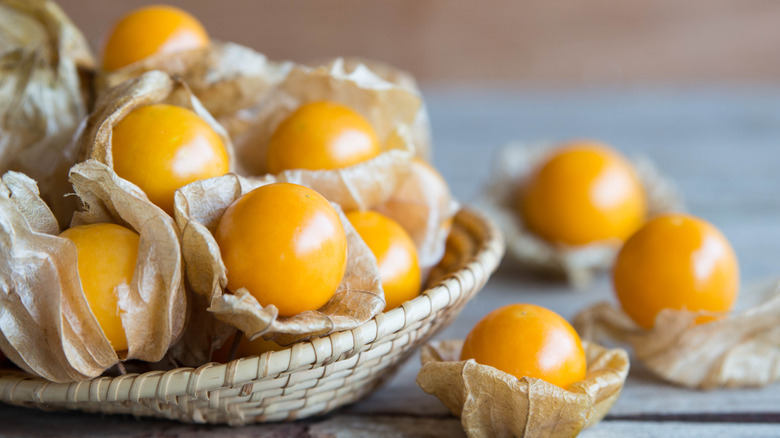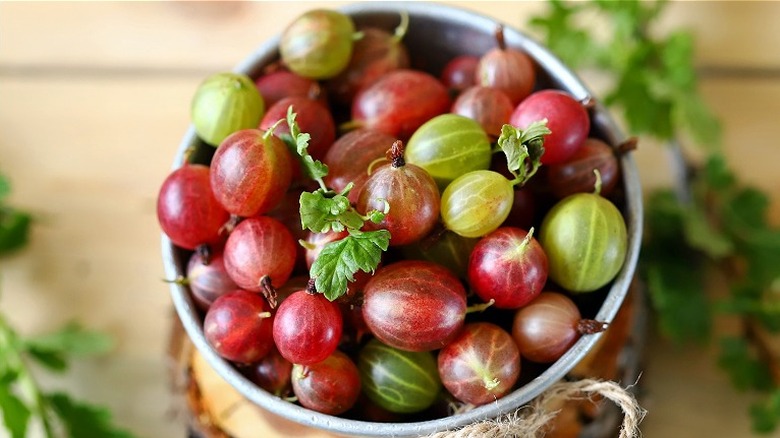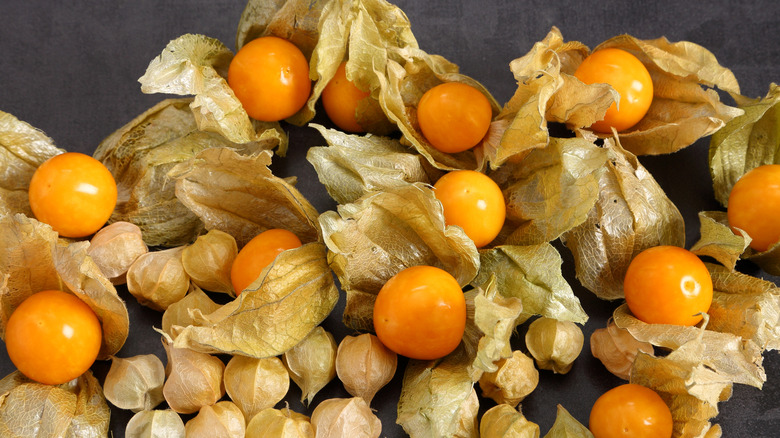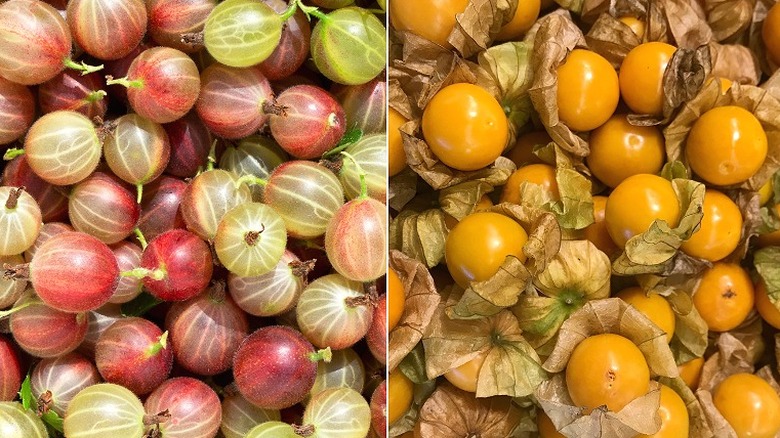The Difference Between Gooseberries And Ground Cherries
If you think that gooseberries and ground cherries are the same thing, you're not alone. Though the two fruits look different, the way they're named creates confusion: Gooseberries are always gooseberries, but ground cherries are sometimes called gooseberries — or a host of other names, including golden berries and husk cherries.
Gooseberries and ground cherries are both small fruits versatile enough to be used in all kinds of recipes, but they are distinct from one another. According to Gardener's Path, gooseberries can range in color from pale green to red to purple and are very juicy. Relatives of the currant, they have a sweet-tart flavor. Ground cherries, on the other hand, grow inside husks much like tomatillos do and are actually from the same plant family, as shared by Good Housekeeping. The fruit inside the husk is a bright orange-gold and also has a sweet-tart flavor. But unlike gooseberries, they have a firmer texture, and some varieties have notes of pineapple. Here are more tips for telling the difference between gooseberries and ground cherries and ways to use them in your cooking.
What are gooseberries?
European gooseberries (Ribes uva-crispa) and American gooseberries (Ribes hirtellum) are members of the same Grossulariaceae family as currants, according to Britannica. The berries grow on the thorny, woody stems of shrub-like plants. The fruits of the gooseberry plants range from ½ inch to 1 inch in size and can be pale yellow, green, red, or dark purple when ripe (via Gardener's Path). Unlike currants, they aren't sold in clusters since they grow individually on the stems. The skin of the berries is somewhat transparent, with pale veins visible just like some types of grapes. When fully ripe, the berries are almost bursting with juice.
How Stuff Works shares that although the gooseberries are extensively grown and used throughout Europe and Russia, the plants are less common in the U.S. That's because the plants were banned in America for most of the last century to protect the lumber industry after it was discovered that they could spread a fungal disease that damages white pines. Although gooseberry plants have begun to make a comeback in the U.S., many states still have restrictions.
What are ground cherries?
According to Permaculture News, ground cherries go by several other names, including husk cherries, goldenberries, husk tomatoes, poha berries, and cape gooseberries. (That last one is likely why ground cherries are so often confused with European gooseberries.) Ground cherries (Physalis pruinosa) grow low to the ground, and the fruits may fall from the plant before they're ripe. But according to Eco Farming Daily, they can be gathered and allowed to ripen off the plant. Another type, Physalis peruviana, has berries that are slightly larger and must be harvested off the plants.
Ground cherries are part of the same nightshade family of plants that include tomatoes, potatoes, and peppers. Another member of this plant family is the tomatillo, and the most distinctive feature of ground cherries is one it shares with tomatillos: The thin husk that encloses the fruit. As ground cherries ripen, their husks turn dry and papery and split open to reveal the fruits. Because ground cherries are part of the nightshade family of plants that contain solanine — a toxic compound — the fruit is the only part of the plant that's edible. But to avoid ingesting solanine, it's important to wait until the cherries are fully ripened before eating them. Good Housekeeping says to look for ground cherries that turn from "light yellow to the warm, apricot gold that signals ripeness." The husks of ripe ground cherries are light tan, brittle, and dry.
How can you tell gooseberries and ground cherries apart?
While it can be challenging to keep the names straight, gooseberries and ground cherries have visual differences that can help you tell which is which. The color of ripe gooseberries depends on the variety and can be shades of pale yellow, green, purple, or red, according to All Recipes. The skin is almost see-through, with pale veins running through the fruit. A bite into a ripe gooseberry reveals a very juicy interior, with a sweet flavor similar to that of grapes but with a tart edge. Green, unripe gooseberries are edible and very tart.
Since ground cherries grow with a papery husk, they may be sold with the husks still attached, which will make identifying them a cinch. If the husks have been removed, the color of ripe ground cherries is a deep, orangey-gold (per Good Housekeeping). While gooseberries have a translucent skin, ground cherries have a solid color. Foods Guy says that ground cherries have a texture similar to that of a cherry tomato, and they can even have the scent and mild flavor of a tomato (same family, after all). However, ground cherries are sweet-tart and also have notes of tropical fruits. If a ground cherry tastes way too tart or unpleasant, that means it's not yet ripe and shouldn't be eaten.
Gooseberry flavor and how to use it
BBC Good Food shares that gooseberries are extremely versatile, well known for their use in all kinds of sweet dishes and drinks, and also delicious in savory recipes. The outlet says to prepare the berries by washing them in cold water and then "topping and tailing the ends," which means slicing the ends off with a knife or scissors. The berries can be made into a compote by mixing them with sugar and a little water, which will break down the fruit into a loose jam. This compote can be used in drink recipes, between cake layers, to make ice cream, and in pies and crumbles. BBC also shares an intriguing recipe for a cloud-like gooseberry pavlova. According to All Recipes, gooseberries can be used in the same way that rhubarb is used to add a tart, acidic note to recipes.
Feel like trying gooseberries in a savory dish? Try BBC Good Food's recipe for a simple gooseberry chutney made with red onion and mustard seed, or try your hand at its spicy gooseberry dressing. Professional chefs shared some of their favorite ways to use gooseberries with Food & Wine, including pickling them, grilling them to bring out their sweetness, blending them into salsa, and making traditional Italian mostarda to add to cheese boards.
Ground cherry flavor and how to use it
According to Foods Guy, the sweet-tart flavor and texture of ground cherries make them great to eat fresh and with salads. They also work well in savory recipes, like when chopped and added to salsas or used as a topping for bruschetta. Honest Cooking uses sliced ground cherries along with fingerling potatoes, caramelized onions, and tomatoes in a beautiful Provençal galette. Meanwhile, Martha Stewart's recipe for a panzanella salad tosses sliced ground cherries with yellow cherry tomatoes, torn ciabatta bread, and an herby vinaigrette.
Ground cherries are also delicious in sweet recipes, lending a unique flavor to pies and baked goods. For example, Good Housekeeping's recipe for a ground cherry-pineapple crumble tosses the fruit with chunks of pineapple under a baked almond-brown sugar topping. Elsewhere, The Kitchn has an easy ground cherry coffee cake recipe with a pecan and cinnamon streusel.
Foods Guy notes that ground cherries aren't always easy to find, and your best bet is to check with local growers and farmer's markets. However, the good news is that ground cherries freeze well, so when you do find them, you'll be able to easily preserve them. Good Housekeeping says to remove the husks, wash the fruits, and then freeze them in a single layer. Once frozen, transfer them to a freezer-proof, resealable bag for storage.





